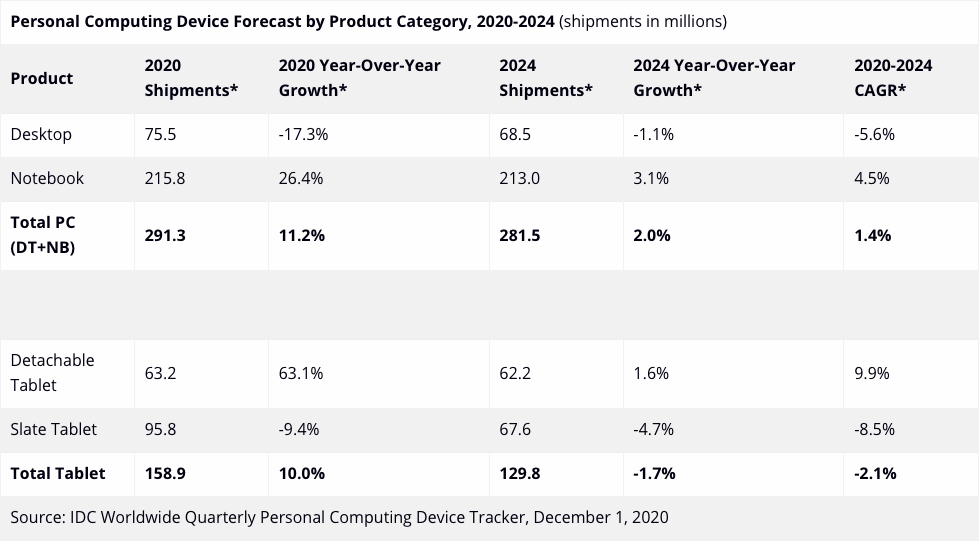Overwhelming Demand for PCs and Tablets Will Continue Into 2021
IDC expects surge in PC shipments to continue into 2021.
Driven by the needs of working from home and remote education, shipments of personal computers and tablets surged significantly this year. This month sales of PCs promise to increase well beyond expectations as demand for systems for home working and learning will be amplified by the holiday spending. Analysts from IDC expect demand for PCs to remain high next year, which might mean that shortages of certain components may persist.
IDC projects that sales of desktops and laptops will increase 18.2% year over year in the fourth quarter of 2020, whereas shipments of mobile devices will surge 26.4% YoY in Q4 2020. In general, sales of PCs this year will increase 11.2% compared to 2019 mainly because of work from home and remote education needs. In fact, shipments of all devices that could be used for work, learning, and/or entertainment are up this year.
"The momentum in the PC market has been impressive to say the least," said Ryan Reith, program vice president with IDC's Worldwide Mobile Device Trackers. "Consumers seem to be buying all ranges of notebook PCs from low-end entry level systems to high-end gaming machines. It is important to note that all of this is happening at a time when other device categories like smartphones, PC monitors, TVs, and gaming consoles are also growing. A clear shift in consumer spend has happened."
It is no secret that it is hard to get AMD's newest CPUs and GPUs, Nvidia's GeForce RTX 30-series graphics cards as well as the latest game consoles from Microsoft and Sony. Meanwhile, it is unreasonable for semiconductor and electronics manufacturers to expand their manufacturing capacities significantly just to meet existing demand as soon as possible and then depreciate additional production tools for years. As a result, there are huge backlogs both in consumer and education segments will go into 2021.
"Earlier this year it seemed like this would be a six-month bump to the industry, but as we look at the supply chain pipeline into 2021, it's clear that the surge has more legs," said Reith. "The education backlog remains extensive and many school districts around the world are doing everything they can to secure inventory."
Demand for desktops and notebooks will remain high next year as well. In fact, IDC predicts that shipments of PCs will rise 1.4% in 2021.
"Not only do we expect more PCs to ship this year and next, but the fundamental shift in everyone's workflow is also expected to have a lasting impact on the PC market in 2022 and beyond," said Jitesh Ubrani, research manager for IDC's Worldwide Mobile Device Trackers. "Longer term forecasts for PC shipments and average selling prices have increased as households inch towards one PC per person while buying PCs further up the stack."
Get Tom's Hardware's best news and in-depth reviews, straight to your inbox.
One thing that is noteworthy about increasing shipments of PCs is that sales of notebooks are growing, whereas sales of desktops are declining even when the whole market is up. IDC projects that 291.3 million of computers will be shipped this year, of which 215.8 million will be laptops and 75.5 million will be desktops.
But after WFH, distance learning, and home entertainment needs will be satisfied, sales of PCs will drop in 2022, based on IDC's projections. However, starting from 2023 they will return to slow growth.

Anton Shilov is a contributing writer at Tom’s Hardware. Over the past couple of decades, he has covered everything from CPUs and GPUs to supercomputers and from modern process technologies and latest fab tools to high-tech industry trends.
-
Giroro I totally understand why somebody with an old low-end computer would have upgraded last summer when suddenly they have to be on it all the time.Reply
It doesn't follow why the kind of person who uses a PC for 10 years would want to upgrade again 6-9 months later.
It also doesn't follow that there's a "backlog" for WFH and education, because since when do coorporations and schools buy high-end cutting-edge components? and why would they be buying them now and in 2021, instead of when this all started?
I think its a lot more likely that the current jump in demand is a mix of bordem and FOMO, which is artificially being amplified by scalper bots flipping as many of the new niche desktop components as possible, which gives the appearance of limited supply.
The real demand is going to dip enough after Christmas that most scalpers are going to have to drop off. So things will level out early January when the mania dies down and we all begin to enjoy a reboot of the 2008 economy. -
spongiemaster Reply
The shortages are for lower end laptops and tablets and peripherals like printers, not for the entire market or any desktop PC's really. I purchase equipment for the company I work for, and even during the height of the shortages, there was no issue buying $1000+ laptops. Under about $600 and it was nearly impossible to find anything for awhile. Even now, Dell is backordered for a month on all their lower end laptops. It's not that people are upgrading from 6-9 months ago, there's been a huge shortage and people are still trying to get systems that they've been trying to get for 6-9 months.Giroro said:I totally understand why somebody with an old low-end computer would have upgraded last summer when suddenly they have to be on it all the time.
It doesn't follow why the kind of person who uses a PC for 10 years would want to upgrade again 6-9 months later.
It also doesn't follow that there's a "backlog" for WFH and education, because since when do coorporations and schools buy high-end cutting-edge components? and why would they be buying them now and in 2021, instead of when this all started?
